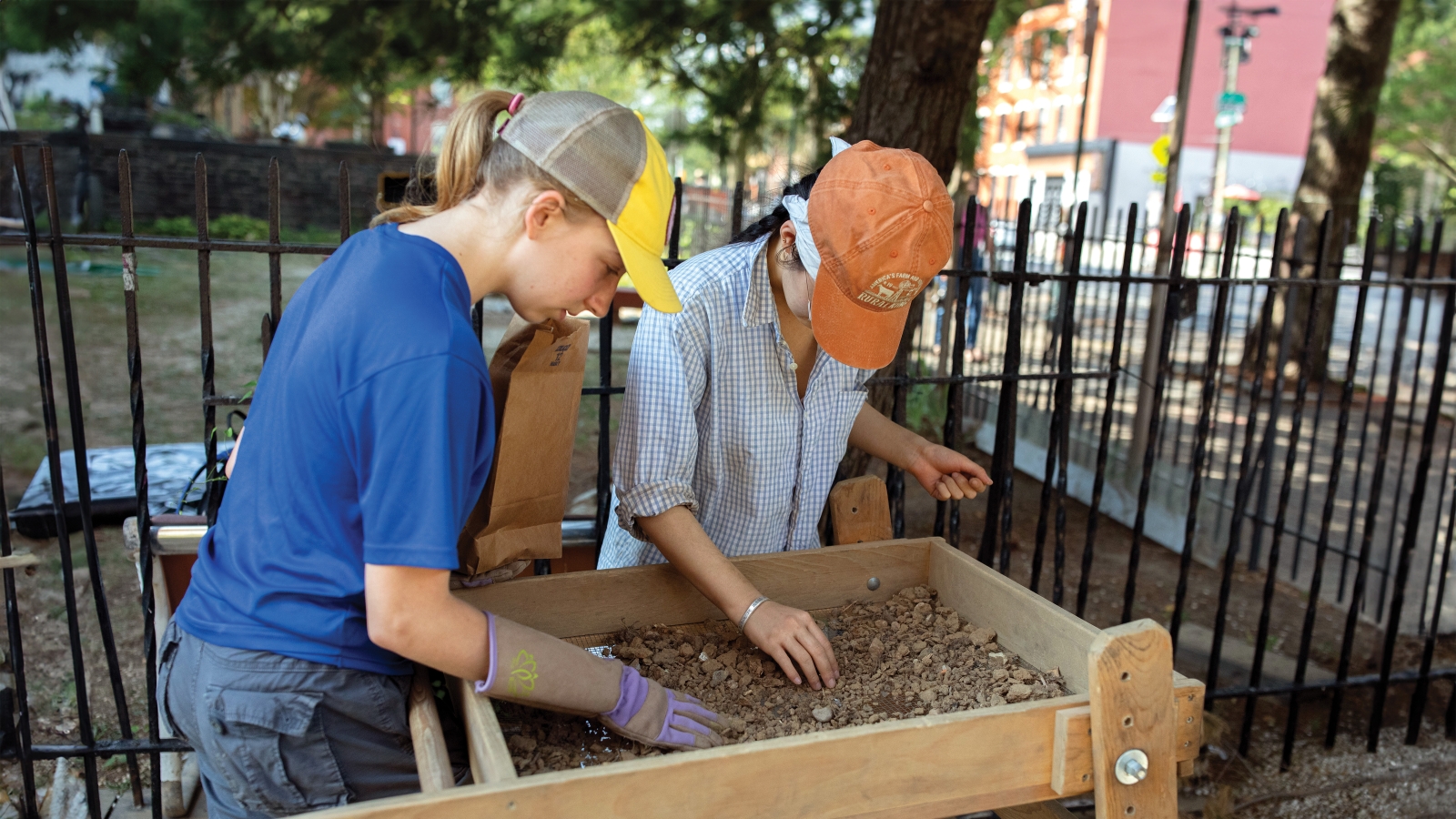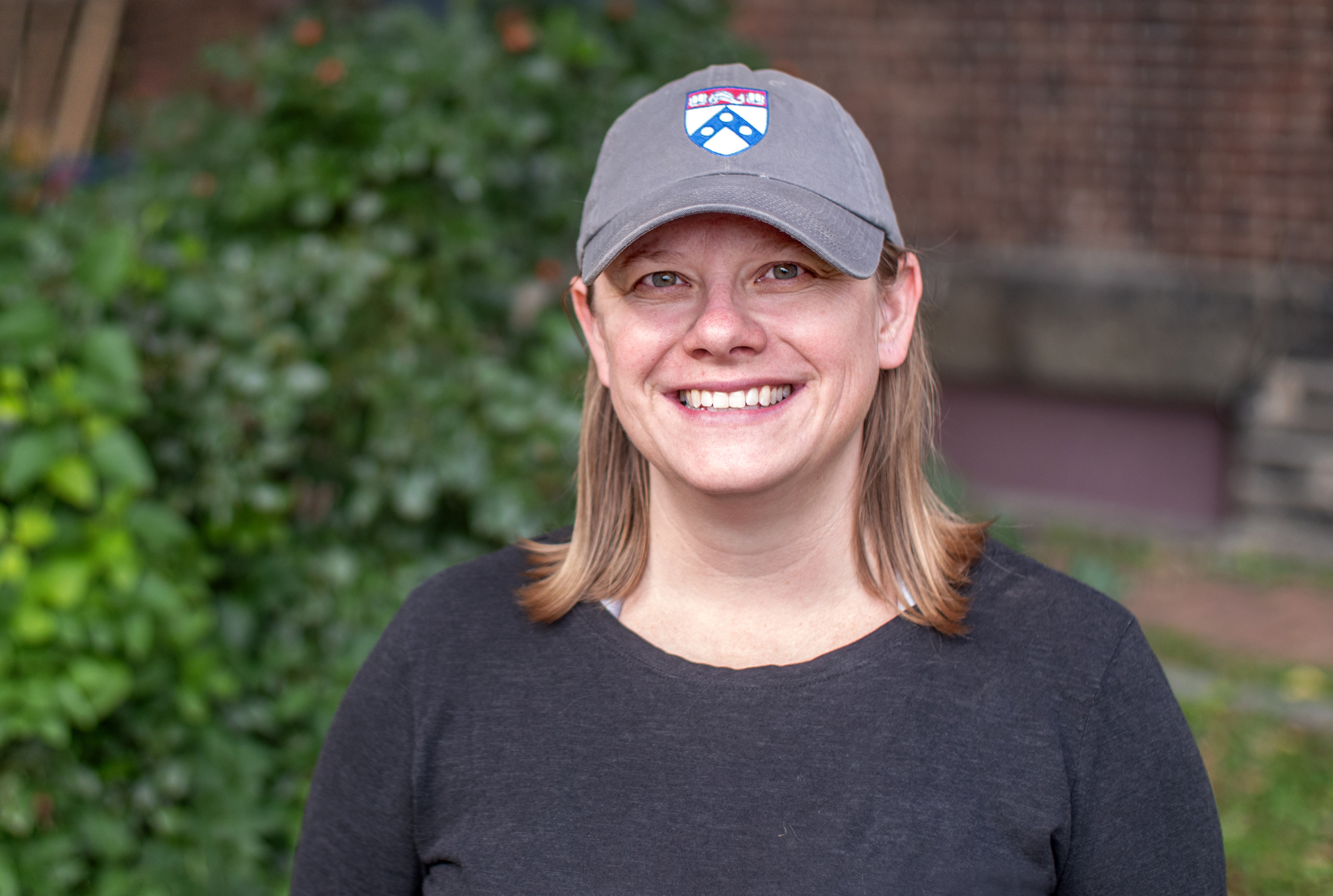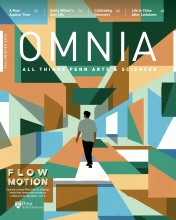Under a blue open-sided tent tucked up close to the brick Community Education Center (CEC) on Lancaster Avenue in Philadelphia, a half dozen people—mostly Penn undergraduates but also at least one grad student and one community member—remove layers of dirt from a 1x2-meter rectangle cordoned off with white string. The September day is hot, 90-plus degrees, with rain threatening and a warm breeze.
Using trowels and shovels and scoops, the group painstakingly works to level off the inner part of the rectangle, dumping all material they collect onto a waist-high sifter. As Sydney Kahn, C’24, gingerly moves the sifter’s wooden handles forward and back, forward and back, small particulates fall through the screen, leaving behind larger bits. Anything notable gets flagged and set aside, and in just a few short hours, the team has bagged pieces of coal and pottery, glass, a button.
They’ll come back the following week, and every Friday through Thanksgiving, to do it again, as part of the course Archaeology in the City of Brotherly Love, taught by Megan Kassabaum, Associate Professor of Anthropology, and Sarah Linn, Assistant Director of Academic Engagement at the Penn Museum, in collaboration with the CEC and other partners. The goal is to teach students the fundamentals of fieldwork at a site close to home and to work closely with the community, all with an eye toward uncovering the stories of those who lived in the Black Bottom neighborhood of West Philadelphia.
“Through this class and this project, we want to make archaeology—both being trained in it and viewing it—open to a much larger audience,” Kassabaum says.
Heritage West, as the project is now called, has been in the works for several years, formally launched in 2021. It began by engaging with the local community to build an interactive, collaborative timeline of the neighborhood, once a thriving spot for Black families. “In the recent past there’s a lot of memory. As you go deep into the history, there’s a lot of understanding,” Kassabaum says. “But there’s a period from the late 1800s through the 1930s or so where there’s not a lot written on our timeline.”
Archaeology, Kassabaum and the others hoped, could try to fill in some of those holes. So, they built out a course during which students could help unearth what archival maps and census data had shown once stood in the area: the remains of seven homes, including some built in the 1840s.
Guided by the results of a geophysical survey the team conducted, the researchers and colleagues spent two weeks in August doing a preliminary excavation, selecting the actual spots where the nine undergraduates and community volunteers would eventually work. “We needed to be sure that when they got here, they weren’t going to dig in a place where there was nothing or where they would spend a significant amount of time on something that we couldn’t easily interpret or explain,” Kassabaum says. “That sense of mystery we have at the beginning of a dig is important, but frankly that mystery period can last for a lot longer than most people want it to.”

Although the course runs the full semester, it only amounts to a total of 10 excavation days—half the time most archaeologists consider the minimum for what they call a field season. Linn and Kassabaum intentionally left the class open to students of all archaeological experience levels to avoid a chasm between them and the community members they had invited to join the dig days.
That’s because interacting and communicating with neighbors is one of the key pedagogical facets of the course, according to both instructors, and it’s the part that Kahn says most excites her. “Each student signs up for two days as a community liaison so we can talk to people about what we’re doing, what we’re trying to learn, answer any questions they have,” she says. “I’m hoping to find a career in informal education after I graduate, and this kind of experience is interesting and important to that path.”
Kahn is one of a handful of students who had conducted previous fieldwork, once in Azerbaijan, another time in rural Illinois. She appreciates how what she’s doing now represents something different from those experiences and a kind of learning that’s much more hands-on than most classroom-based courses she’s taken to this point. “I was excited to get some of that tactile experience back into my day-to-day,” she says.
By the end of the semester, the students will have completed weekly field journals and reading reflections, as well as a final project focused on an artifact or feature from the site. Kassabaum and Linn aim for these processes, in conjunction with the dig itself, to give the undergraduates at least a sense of what this kind of fieldwork entails. In the spring, members of the Heritage West project and additional volunteers will analyze what the students and community members have found.
“For Penn students, fieldwork opportunities almost always take place in the summer. Having something during the academic year, for class credit, felt important in terms of their training,” Linn says. Beyond that, “archaeology in the city of Philadelphia is not usually an academic enterprise or it happens in places like Old City. We wanted to redirect some of that energy to a historic Black neighborhood.”
Back at the site, Kahn and classmates continue leveling off their rectangle, guided by sixth-year anthropology Ph.D. student Autumn Melby. “Let’s not go any deeper here,” she says. “See how there’s some yellowish soil popping up over there? We might be seeing something different.” Which is, after all, the point, for the students taking the class and for the communities they’re partnering with.





